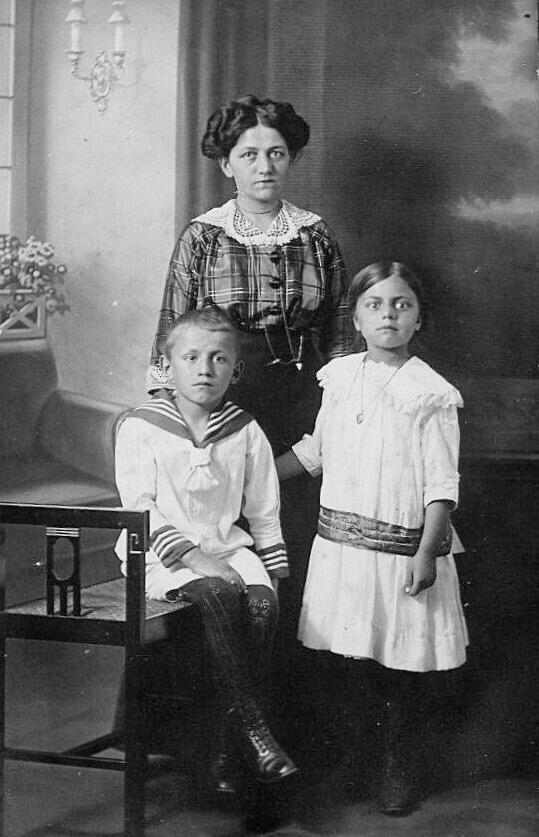
Sailor Suits: Chronology--20th Century Trends

Figure 1.--Sailor suits were very popular for boys in the early 20th century, but declined in popularity after World War I. This trend varied somewhat from country. Here we see a German family. We are not sure how to date it, but would guess the 1910s. A German photo collector dates the portrait on the basis of the fashionsto the World War I era (1914-18). Note the father is absent from the portrait, probably at the Front.
|
|
By the early-20th century the sailor suit was among the most popular style for boys and girls. Although we note that the style was more popular in other countries than in England itself. The sailor suit was especially popular in France and Germany, but they were also very popular in America. Sailor suits were very popular for European royals and this must have been a factor for the popularity with the general public, especially the middle-class. The sailor suit continued to be widely worn throughout the Edwardian era. After World War I it began to decline in popularity for boys. Styling became increasingly traditional in the 20th century. A factor here was the popularity among girls. Older boys began turning away from sailor suits, although varird substantially from country to country. Aftr World War II only very young boys wore sailor suits, although many girls' dresses continued to be done with sailor styling.
Early 20th Century (1900-20)
By the early-20th centuruy the sailor suit was among the most popular style for boys and girls. Although we note that the style was more populr in other countries than in England itself. Here a factor was that many boys from affluent families went to their boarding schools at age 8 years and stopped wearing sailor suits. The sailor suit was especially popular in France and Germany, but they were also very popular in America. Sailor suits were very popular for European royals and this must have been a factor for the popularity with the general public, especially the middle-class. The English princes wore them as well as German and other European royalty. The sailor suit continued to be widely worn throughout the Edwardian era. There were many different styles in addition to the standard, traditionally styled suit. There are hundred of examples archived on HBC. A good example is an unidentified American boy in the 1900s. Styling became increasingly traditional in the 20th century. We note American boy Ralph Patterson Olmstead in 1912. The fashion declined in popularity in America during the 1920s, becoming a style mostly for younger boys. The sailor suit, however, continued very popular in Germany and Italy during the 1920s, but had begun to decline in the 1930s.
Inter-War Years (1920-45)
Boys after World War I still commonly wore sailor suits. This was especially the case in te early 20s. They began to decline in popularity for boys, but were still commonly worn. A factor here was the popularity among girls. Older boys began turning away from sailor suits, although trends varied substantially from country to country. In American and Britain we mostly notice younger pre-school boys and younger primary school boys wearing sailor suits. A good example is Harold Mussman in 1937. School portraits from the period often show beginning primary classess with some boys wearing sailor suits. We still them commonly featured in mail-order catalogs. Here we note sailor suits with traditional styling as well as other outfits with sailor-styling influences. In Frace and Germany, however, they were more popular. We still see younger teenagers wearing them in many European countries. .
Mid-20th Century (1945-70)
After World War II only very young boys wore sailor suits, although many girls' dresses continued to be done with sailor styling. We no longer see American boys wearing sailor suits to school. They were also no longer common in Europe. We do note French boys wearing sailor suits for First Communion. We also note boys' choir with sailor suit uniforms. The fashion for older boys eventually passed out of fashion on the continent after World War II (1945). Uniforms in general passed out of favor in Germany as well as other countries. This was a factor in the demise of the sailor suit, bur the more important dactor was probanly that boys began seeing it as a style for little boys and girls. The time-line, however varied from country to country.
Late-20th Century (1970-2000)
We rely see boys wearing sailor suits in the late 20th-century. Some very young boys such as tdlkers might wear them. Or e occassionally see boys in formal weddings wearing sailor suits. Also a few boys' choirs continued to have sailor suit uniforms.
HBC

Navigate the Boys' Historical Clothing Web Site:
[Introduction]
[Activities]
[Biographies]
[Chronology]
[Clothing styles]
[Countries]
[Bibliographies]
[Contributions]
[Essays]
[FAQs]
[Glossaries]
[Images]
[Links]
[Registration]
[Tools]
[Boys' Clothing Home]
Navigate the Historic Boys' Clothing Web sailor pages:
[Return to the Main sailor suit Century trend chronology page]
[Return to the Main sailor suit page]
[Middy blouse]
[Reefer jackets]
[Sailor dresses]
[Other sailor styles]
[Sailor hats]
[Middy suits]
[National sailor suits]
[The Royals]
[Ring bearer/page costumes]
Created: 6:20 PM 3/4/2007
Last updated: 2:03 AM 2/2/2010



